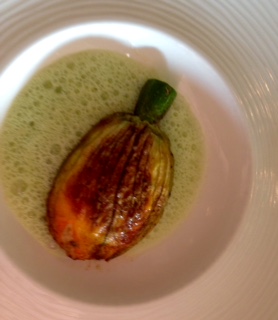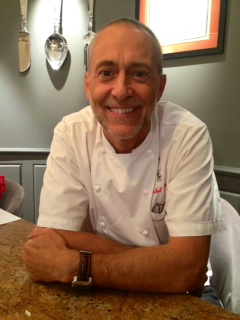When Graham Neville served courgette flowers stuffed with a prawn and scallop mousse in a lovage sauce to showcase the garden menu at a foodwriters’ dinner in Restaurant Forty One, where he is head chef, there were gasps around the table and the Tweets took flight. Because instead of the new Nordic style interpretations of Irish food inspired by Rene Redzepi of Noma which we have become used to in the past few years, with carefully arranged dots of sauces and ingredients scattered around a dark stone coloured plate, what he was serving was classic French cuisine, a style of cooking – if you are to follow the trends on the World’s 50 Best Restaurants list – which was relegated to ‘vieux chapeau, démodé’ status over 10 years ago when Spanish chef Ferran Adria burst onto the worldwide culinary scene with an armoury of foams, gels and spheres.
Modern Techniques are about Bells and Whistles, not Taste
“There are a lot of modern techniques around, which I use a bit, but the thing is, French cookery is based around very tasty, wholesome food,“ says Graham Neville, who swept the boards at the 2014 Food & Wine Magazine Awards, winning Best Restaurant in Dublin, Best Chef in Dublin and Best Chef overall in Ireland. “Some of the modern techniques are more about bells and whistles rather than taste. People are not as interested in the dots; food that doesn’t have a foundation and doesn’t always taste of itself. French food mightn’t look as pretty as the plates with loads of colourful dots and swirls, but it will always taste good. I think more people are aware of that now. I used to technically do a lot more than I do now, but I’m now putting fewer ingredients on the plate and allowing them to speak for themselves. You can be a busy fool. This is actually less work, but you’re using your brain a bit more. For me it’s about the lightness and the taste. And sauces are coming around again. For me, the sauce is very important because it pulls everything together on the plate. The sauces aren’t thick, creamy and buttery like they used to be; they’re light, and essences and juiced fruits and vegetables. It’s the classics but lighter.”
And he’s not alone. Amid the recent Nordic and equally popular hipster trends with subway tiles, exposed light bulbs, drinks in jam jars and down and dirty barbeque ribs, the Gallic influence is creeping back onto menus around Dublin and there is a renewed interest in the French classics. More ecently opened restaurants with a resolutely French menu include Brioche in Ranelagh, where Gavin McDonagh serves tasting plates of classical French dishes.
“The French influence is starting to come back in. It’s always going to be in essence, coming from French techniques; it’s never going to be Nordic,” says McDonagh. “In Brioche, we focus on flavour. You can have all those new gels and foams on the plate and they may look pretty, but if they don’t taste of much, it’s a waste. And I tend to stay away from the Nordic presentation style. It’s more scattered and flatter on the plate; I find it too rustic, I prefer the French style which is cleaner. What we try to do is take two or three ingredients, and let them be the hero of the plate. I think lots of flavours confuse people.”
Classics Never Go Out of Fashion
For some long established French restaurants like Dax and Restaurant Patrick Guilbaud in Dublin, this is their recipe for success. “Classics never go out of fashion, for food or clothes,” says Patrick Guilbaud. “What the Spanish, Italian, Japanese and Asian food bring to the table, is a difference, but with all food you must cook it well. You can twist dishes a little bit but a classic is a classic. People travel a lot to Asia, Norway, Spain and they come back with different ideas, and that’s good. But people want to understand what they’re eating. They are fed up of going into a restaurant which is a mixture of tastes they can’t cope with.”
As Ireland’s only restaurant that holds two Michelin stars, Restaurant Patrick Guilbaud is considered by many to be an outstanding French restaurant. Its many fans include Michel Roux Jr – former presenter for six years on Masterchef: The Professionals, and executive chef and owner of Michelin two-star Le Gavroche in London – who had dinner there when he was a guest speaker at Taste of Dublin last year.
“Why do we always harp on about the classics? Why do we always enjoy eating them?” asks Roux. “Because they’ve stood the test of time. Because they give us as much pleasure now as they did 20, 30, 60, years ago. They’ve only been tweaked. They’ve only been slightly addressed in the way that they’re cooked. Lightened up slightly maybe, with less cream, less reduction and so on and so forth. But they’re still the true classics; they’re still the true dishes. They’re classics for a reason, and you can’t get away from that.
Will Spherification be a Classic? Asks Michel Roux
“Will we still be seeing spherification elBulli style in 20 years time? Will people sit down to a plate of olive oil caviar and go mmmmmm I remember when I first tasted that 30 years ago? I don’t think so. So they’re classics because they’ve stood the test of time,” he says. “When you go to a restaurant you don’t want to be too challenged. Yes, sometimes I go to restaurants where I want to be challenged, like The Fat Duck, it’s a wonderful experience and places like elBulli. But it’s not one you want to repeat too often. When you go to a restaurant, you want to be cosseted, comforted and just enjoy it; and not be over challenged, and just really tuck into some glorious food with a good bottle of wine in that glorious moment in time.”
While Roux is quick to acknowledge that there has been a renaissance throughout Spain of great chefs using modern techniques to showcase their food, and that Redzepi’s Nordic cuisine has really brought to the fore the fact that you can cook great food from ingredients that truly are indigenous without the classics of butter, cream and foie gras; he believes that French food is as relevant as ever. “I think French cuisine has never actually gone out of fashion. I think it may have lost its way a little bit, especially in France, but it’s never really gone out of fashion. It’s comfort food; its food you take great pleasure in eating. And it’s also in many respects pleasing food, and it’s pleasing to the diner because you can just sit down and eat, and you’re not lost,” he says.
“ It’s structured. There’s a proper start and a proper end and you don’t get lost with 20 different courses in between. There’s a starter, a main, sometimes a middle, sometimes a cheese and a dessert. It’s easier for the senses to understand as well. Because when you have a tasting menu of 10, 20 sometimes 30 courses; they’re not courses, they’re spoons; and it’s extremely confusing and you just can’t remember them. You may remember one or two because they were exceptionally good; and you’ll probably remember five or six because they did not go down so well. I have issues with very, very long tasting menus. Because they’re not pleasurable and I think most diners would agree with me. You get more pleasure with a real structured meal, something that you can enjoy more than a mouthful. Our tasting menu is seven courses and is just about manageable. My issue with this modern style of extra long tasting menus is that it isn’t very wine friendly. It’s very difficult to choose an expensive wine for a 20 course tasting menu because a lot of it may not go with the menu and it’s tough,” he says.
Roux maintains that chefs should have a solid grounding in the French classics before they start to “spread their wings” and when it comes to French restaurants, buzzy bistros are as important as fine dining restaurants.
So what about the future of French food, and are we likely to see more and more French restaurants opening? “I do think that there’s a renaissance in France,” says Roux. “There’s still a major issue. France is in a bad situation politically and financially which is affecting all industries; but I think especially the manual industries such as catering. And I think we’ve lost two or three generations of young budding chefs in France that just can’t make ends meet in France, have just lost their way, become lazy and are in a rut. But times are changing, especially in Paris. Paris now has a very vibrant new style bistro scene; things are changing for the better, but none the less still based on the classics, which is good.”
And in Dublin, the outlook is totalement Française. “Good things will never go out of fashion,” says Neville. “Fads may come and go. The Spanish team will come in, the Nordic team; but at the end of the day, the French were the first at it and it’s the basis of most cooking.”






